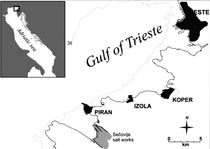Chemical Composition of Natural Sea Salt from the Sečovlje Salina (Gulf of Trieste, northern Adriatic)
Keywords:
northern Adriatic Sea, Sečovlje salina, microbial mat-petola, natural salt, elemental compositionAbstract
In our research the concentrations of major and minor elements were determined in natural sea salts from the Sečovlje salina (Piran salts, Slovenia) and compared to those of selected samples of commercially available unrefined salts with different geographical origins (Croatia, Austria, Italy, Portugal, India, and Pakistan). In the case of major element contents such as sodium (Na), iron (Fe), aluminum (Al), manganese (Mn), and titanium (Ti) many similarities were observed among the analysed salt samples. On the other hand, Piran salts are characterized by lower silicon (Si) values. Among the salts from the Sečovlje salina, the salt with the trade name Piran salt has a higher Mg content while Flower of salt has a lower concentration of calcium (Ca). In Slovenian samples the majority of trace element values were lower than 0.5 μg g–1, which was comparable to the results from commercially available unrefined salts. The salt composition differences observed indicate area-specific signatures related to geographic origin and diverse salt production processes. The quality of the studied salt samples is in accordance with standards established by the Codex Alimentarius Commission and the Piran salts are also suitable regarding issues of national food control.

Downloads
Published
Issue
Section
License
Except where otherwise noted, articles in this journal are published under the Creative Commons Attribution 4.0 International License
